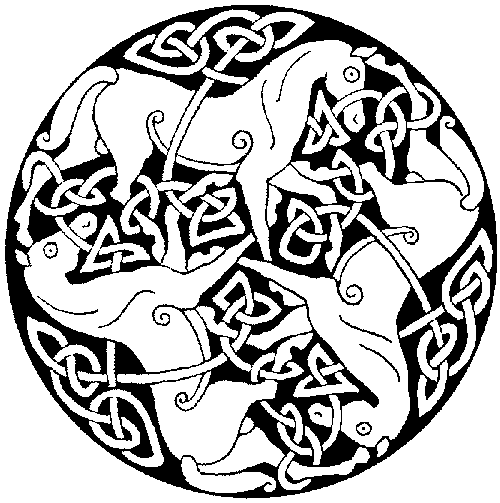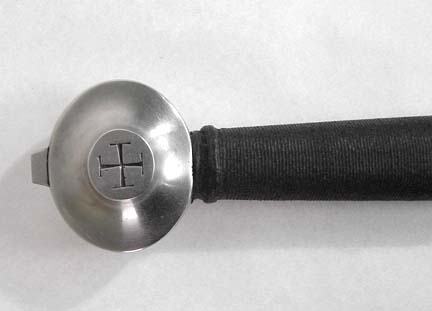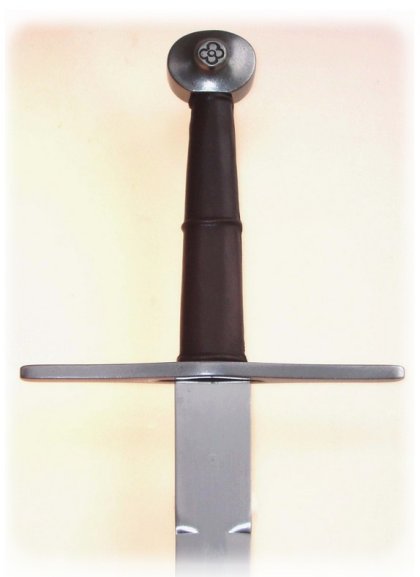
| myArmoury.com is now completely member-supported. Please contribute to our efforts with a donation. Your donations will go towards updating our site, modernizing it, and keeping it viable long-term.
Last 10 Donors: Graham Shearlaw, Anonymous, Daniel Sullivan, Chad Arnow, Jonathan Dean, M. Oroszlany, Sam Arwas, Barry C. Hutchins, Dan Kary, Oskar Gessler (View All Donors) |
| Author |
Message |
|
Karl Knisley
|
 Posted: Wed 22 Jul, 2009 2:14 pm Post subject: Pommel decoration Posted: Wed 22 Jul, 2009 2:14 pm Post subject: Pommel decoration |
 |
|
Hello
Do you like this decoration or should I do something else?Opinions?
Thanks
|
|
  |
 |
Etienne Hamel

Location: Granby (QC) canada Joined: 09 Sep 2006
Posts: 443
|
 Posted: Thu 23 Jul, 2009 7:47 am Post subject: Posted: Thu 23 Jul, 2009 7:47 am Post subject: |
 |
|
it looks great i wish i could found one for free  a cross would fit in the design too. a cross would fit in the design too.
|
|
  |
 |
M. Eversberg II

|
 Posted: Thu 23 Jul, 2009 9:54 am Post subject: Posted: Thu 23 Jul, 2009 9:54 am Post subject: |
 |
|
I like it so much as the photos (which are blurry I'm afraid) can show me. What is it?
M.
This space for rent or lease.
|
|
      |
 |
Nathan Robinson
myArmoury Admin


|
 Posted: Thu 23 Jul, 2009 10:14 am Post subject: Posted: Thu 23 Jul, 2009 10:14 am Post subject: |
 |
|
Hi Karl-
I'm afraid I don't care for the design, myself, as it's very anachronistic. (different time period, different culture, different style of art, etc.)
| M. Eversberg II wrote: | | I like it so much as the photos (which are blurry I'm afraid) can show me. What is it? |
Hm. Weird. The second photo, if anything, is over-sharpened, not blurry.
It looks like the Celtic "three horses".
 Attachment: 12.25 KB Attachment: 12.25 KB

.:. Visit my Collection Gallery :: View my Reading List :: View my Wish List :: See Pages I Like :: Find me on Facebook .:.
|
|
    |
 |
Brian K.
Industry Professional

Location: Salt Lake City, Utah Joined: 01 Jan 2008
Posts: 727
|
 Posted: Thu 23 Jul, 2009 10:40 am Post subject: Posted: Thu 23 Jul, 2009 10:40 am Post subject: |
 |
|
For me, I prefer pommel decor that fit's inside of a pommel recess. Most of the time, pommel decor placed on a flush surface looks 'forced', and looks out of place. Not to mention, if the design doesn't suit the era.
Brian Kunz
www.dbkcustomswords.com
|
|
   |
 |
Andrew Pribor

|
 Posted: Thu 23 Jul, 2009 10:47 am Post subject: Pommel decoration Posted: Thu 23 Jul, 2009 10:47 am Post subject: Pommel decoration |
 |
|
I think I have to agree with Nathan on this one. I recently 'almost' placed a simular style pendant in my Windlass type IV & realized it didn't work at all for the same reasons as he noted.
"The Bow brings grief and sorrow to the foeman; armed with Bow may we sudue all regions."
|
|
  |
 |
Roger Hooper

|
 Posted: Thu 23 Jul, 2009 1:22 pm Post subject: Posted: Thu 23 Jul, 2009 1:22 pm Post subject: |
 |
|
Something simple engraved or etched on the pommel surface might work out better. For instance, a Cross potent like the one on the albion Baron, or the flower on DEL Tin DT2146
 Attachment: 28.69 KB Attachment: 28.69 KB

Albion Baron
 Attachment: 17.29 KB Attachment: 17.29 KB

DT2146 from Art Elwell's a-work-of-art website
|
|
  |
 |
G. Ghazarian
Industry Professional

Location: Florida USA Joined: 01 Nov 2005
Posts: 216
|
 Posted: Thu 23 Jul, 2009 1:29 pm Post subject: Posted: Thu 23 Jul, 2009 1:29 pm Post subject: |
 |
|
Karl, your pommel does not need any decoration. The antique look is sufficient just by itself.
Anything you put on it will look out of place and foreign.
My 2 cents.
G. Ghazarian
http://gloryships.com/
|
|
   |
 |
|
Jean-Carle Hudon
|
 Posted: Thu 23 Jul, 2009 2:22 pm Post subject: anachronisms and collecting Posted: Thu 23 Jul, 2009 2:22 pm Post subject: anachronisms and collecting |
 |
|
Karl,
It depends on what you are looking for. If you wish to keep that sword within the realm of historical reproduction, then the celtic trilogy is outdated by a millenia. On the other hand, many of us drift back and forth from reenactment and historical propriety to the more accessible fun & games of anachronism and pseudo-medieval groups. If that's the case, then maybe your invented character has a celtic lineage in a medieval time frame, so you are looking for decorations that bring this to the forefront, and then it becomes purely a question of personal preference & aesthetics.
Aesthetically, without regards for historical context, I find the horse trilogy very attractive. You could eventually get a scabbard chape worked with the same symbols, as there are now on this site quite a few artisans who show first rate metal work and scabbards... but if you want backing in terms of historical correctness, then I don't think that will happen.Cheers, JC.
Bon coeur et bon bras
|
|
  |
 |
|
Karl Knisley
|
 Posted: Sun 26 Jul, 2009 8:35 pm Post subject: Posted: Sun 26 Jul, 2009 8:35 pm Post subject: |
 |
|
Hello
Thanks everyone for the imput:-) I guess i`ll leave the pommel bare.That brokes a question though.Would a Scott or Irish knight, of the 13th century,decorate his kit in Celtic motif?That being kindof thier heritage.
Thanks
|
|
  |
 |
|
Kel Rekuta
|
 Posted: Sun 26 Jul, 2009 11:17 pm Post subject: Posted: Sun 26 Jul, 2009 11:17 pm Post subject: |
 |
|
|
No, Celtic knotwork art was long out of style at that point, by a couple hundred years. Plain wheel pommels like everyone else, some with elongated tips were coming in during the fourteenth century. Cruciform hilts and Christian symbolism seems to have been popular then, especially in the Highlands and Islands. Lowlanders used exactly the same hardware as their English or Continental neighbors.
|
|
   |
 |
Thom R.

|
 Posted: Sun 26 Jul, 2009 11:19 pm Post subject: Posted: Sun 26 Jul, 2009 11:19 pm Post subject: |
 |
|
in a word - unlikely.  much of what today is considered "celtic art" is really pre-christian, i.e. bronze and very early iron age. much of what today is considered "celtic art" is really pre-christian, i.e. bronze and very early iron age.
de Clare, de Burke, Fitz Stephen, Fitz Gerald, de Courcy, de Umfraville, de Soules, de Bruce, Balliol, Comyn...... I could go on these are just a few that come to mind while typing............... these are all Norman surnames. the Normans invaded Ireland in 1171 and had made in-roads into Cumberland and Scotland well before that. By the time of Edward I of England and the death of Alexander III, many of the Scottish knights or nobles were descended from Normans, Robert Bruce and John Balliol, being the two obvious heavies contending for the crown. Both were of Norman descent. The western Highlands and Isles of course being culturally a bit more isolated.
Also, what passes today for "celtic art" was actively suppressed by the church in the 12, 13th centuries as being pagan and heretic. just in general most artwork in the 13th c is christian in theme, including Ireland and Scotland. I don't know that we have any decorated pommels from the 12th-14th centuries that have definite Scottish or Irish provenance.
We also have records of the coats of arms of many of the Scottish nobles (and the Anglo-Irish), and there isn't much in the way of what today people think of as "celtic artwork" involved, at all. Indeed the whole concept of heraldry is really a continental European thing brought to England Ireland and Scotland by the Normans. So I guess what I am saying is I agree with Nathan, the three horses are very anachronistic. But it's your sword and you should decorate it as you like. If you are interested in genetics, Brian Sykes did a followup book specifically looking at DNA in the Ireland England and Scotland. Its interesting to say the least. The book is called Saxons Vikings and Celts, the genetic roots of Britain and Ireland. The gist is that the culture and politics (who is in charge) change much more over time than the genetics of the common people despite invasions by Romans, Angles, Jutes, Saxons, Danes, Nords, and Normans. tr
|
|
  |
 |
Roger Hooper

|
 Posted: Sun 26 Jul, 2009 11:50 pm Post subject: Posted: Sun 26 Jul, 2009 11:50 pm Post subject: |
 |
|
| Thom R. wrote: |
If you are interested in genetics, Brian Sykes did a followup book specifically looking at DNA in the Ireland England and Scotland. Its interesting to say the least. The book is called Saxons Vikings and Celts, the genetic roots of Britain and Ireland. The gist is that the culture and politics (who is in charge) change much more over time than the genetics of the common people despite invasions by Romans, Angles, Jutes, Saxons, Danes, Nords, and Normans. tr |
Forgive me for going more offtopic, but that statement reminds of the genetic link found between "Cheddar Man" a 9000 year old skeleton found in England, and modern residents of the nearby village of Cheddar. - http://en.wikipedia.org/wiki/Adrian_Targett -
Please, no cheese jokes 
|
|
  |
 |
David McElrea

|
 Posted: Sun 26 Jul, 2009 11:55 pm Post subject: Posted: Sun 26 Jul, 2009 11:55 pm Post subject: |
 |
|
I'm going to both agree and disagree with your post, Thom.
I agree that this piece is anachronistic. While I am unsure of the image's provenance, it has the looks of something one might find on a Pictish cross.
I disagree with this statement.
| Quote: | | what passes today for "celtic art" was actively suppressed by the church in the 12, 13th centuries as being pagan and heretic. |
Actually, I think the reverse is true. What most people think of as "celtic art" (meaning pagan Irish or Brythonic art) is actually a post-Christian development. Look at the Book of Kells or Durrow or any of the Irish or Scottish high crosses. This mixture of organic and zoomorphic points to a fusion of Irish, Picitish and Anglo-Saxon art forms and is most often found in ecclesiastical art. This belongs to the centuries following the Christian ascendancy and has nothing to do with the ultimate La Tene forms that would have predominated in the Pre-Christian Iron Age.
But art forms evolve. The Ultimate La Tene was fused together with (and eventually gave way to) the more complex knotwork patterns which are relatively common up until (I think) the late 11th century . Eventually the Normans would bring their continental tastes to bear on their surroundings and we see a flourishing of romanesque et al. No suppression-- just a natural evolution.
My thoughts...
|
|
  |
 |
|
|
You cannot post new topics in this forum
You cannot reply to topics in this forum
You cannot edit your posts in this forum
You cannot delete your posts in this forum
You cannot vote in polls in this forum
You cannot attach files in this forum
You can download files in this forum
|
All contents © Copyright 2003-2025 myArmoury.com — All rights reserved
Discussion forums powered by phpBB © The phpBB Group
Switch to the Basic Low-bandwidth Version of the forum
|

